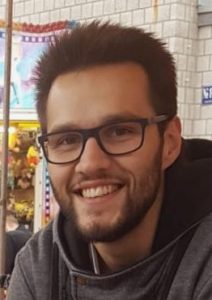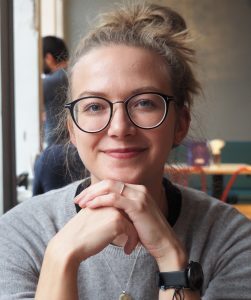Best poster prizes at ‘Recent advances in structural biology of membrane proteins’
Over 60 posters were presented at the virtual EMBO Workshop ‘Recent advances in structural biology of membrane proteins’, highlighting the importance of lipids in MP research and how they can be preserved. There were two live poster sessions and the presenters could also be contacted via chat, message or video call throughout the conference – their work was then voted for by other attendees and speakers. We are pleased to be able to share with you the research from the three winners of the best poster prizes: congratulations to Kevin, Natalie and Karthik!
Cryo-EM Snapshots of Nanodisc-Embedded Native Eukaryotic Membrane Proteins
Presenter: Kevin Janson

Abstract
New membrane complex purification technologies in combination with cryo electron microscopy (cryoEM) recently allowed the exploration of near native membrane protein complex architectures. Polymer nanodiscs in particular provide the basis to study overexpressed membrane proteins at high resolution while retaining protein—protein and protein—lipid interactions. However, how the majority of endogenous membrane proteins are organized remains elusive, mainly due to the inherent complexities that a hydrophobic environment poses to biochemical preparations.
In this work, we combined biochemical enrichment protocols for native membrane complexes together with amphiphilic polymers to increase the quality of recovered endogenous membrane complexes. The derived protein encapsulated nanodiscs were identified by mass spectrometry and imaged with cryoEM. This set of technologies is applied to Chaetomium thermophilum, a thermophilic fungus, that confers additional advantages for protein structure determination due to the increased thermal stability of its biomolecular assemblies.
Our results show a highly efficient recovery of protein encapsulating nanodiscs, amenable to structural and biophysical characterization with a multitude of methods. Initial mass spectrometry results reveal ~1300 proteins while multiple 2D class averages from cryoEM data show prominent nanodisc embedded structural signatures. This combined methodological approach to isolate multiple endogenous membrane protein complexes provides unprecedented opportunities for a deeper understanding of the membrane proteome of a eukaryote.
Structural studies and inhibition of essential pathogenic secondary active transporters with synthetic nanobodies and solid supported membrane electrophysiology
Presenter: Natalie Bärland

Abstract
Single domain antibodies (nanobodies) have been extensively used in mechanistic and structural studies of membrane proteins. Additionally, to their traditional use in aiding structural elucidation they harbour a great potential as tools for clinical therapies. Nanobodies are specifically selected to target the protein of interest with high affinities and are capable of trapping specific states with inhibitory potential. A high throughput identification of inhibitory nanobodies is essential for subsequent studies and often challenging if a technique consumes large amounts of sample or if the required labelling for their characterisation is costly. Solid supported membrane (SSM) electrophysiology has been a fast way to screen and characterise electrogenic transport of compounds and can be expanded for the identification of putative nanobody inhibitors. Here we show a combination of structural studies assisted by synthetic nanobodies (sybodies), selected by using SSM electrophysiology to screen and identify inhibitors. As our model protein we used the secondary active transporter LicB, which is a choline importer essential for the survival of the pathogen Streptococcus pneumoniae in the host. S. pneumoniae is a highly invasive pathogen that can exhibit multiple resistances to antimicrobials and remains to be a burden for society. The methods described here can be applied for the characterization of any electrogenic transporter. It can help to screen and select with a high throughput putative inhibitory sybodies and help in the development of novel drugs and drug targets.
Structural and functional properties of a magnesium transporter of the SLC11/NRAMP family
Presenter: Karthik Ramanadane

Abstract
Divalent transition metals are essential nutrients whose uptake is mediated by membrane transporters of the SLC11/NRAMP family. Over the last 25 years, family members have been characterized as proton coupled divalent transition metal symporters, a property, which was later supported in structural and functional studies of prokaryotic homologues. In this study, we have combined the phylogenetic analysis of SLC11 proteins with their biochemical characterization to show that the transition metal ion transporters only represent a fraction of the SLC11/NRAMP family. After extensive screening, we have identified a family member with diverging properties, which was successfully purified and reconstituted. In transport studies, we were able to classify this protein as a prokaryotic NRAMP related magnesium transporter from Eggerthella lenta (ElenNRMT). Unlike known members of the SLC11/NRAMP family, ElenNRMT does not co transport protons along with its primary substrate. These observations are partly contradicting previous studies on the substrate selectivity within this family. To gain insight into the structural basis of the distinct substrate selectivity, ElenNRMT was characterized by single particle cryoEM in absence and presence of Mg2+ at respective resolutions of 3.5 Å and 4.1 Å. Using X ray crystallography, we were able to confirm the location of the bound substrate using the anomalous scattering properties of Mn2+. In all structures, ElenNRMT adopts an inward facing conformation revealing an ion binding site that differs from classical NRAMP transporters in its volume and the distinct residues mediating ion interactions. Together, these results define the determinants of the diverse selectivity in the SLC11/NRAMP family and provide insight into its evolution.
Congratulations to all three winners!
The EMBO Workshop ‘Recent advances in structural biology of membrane proteins’ took place from 29 November – 1 December 2021.